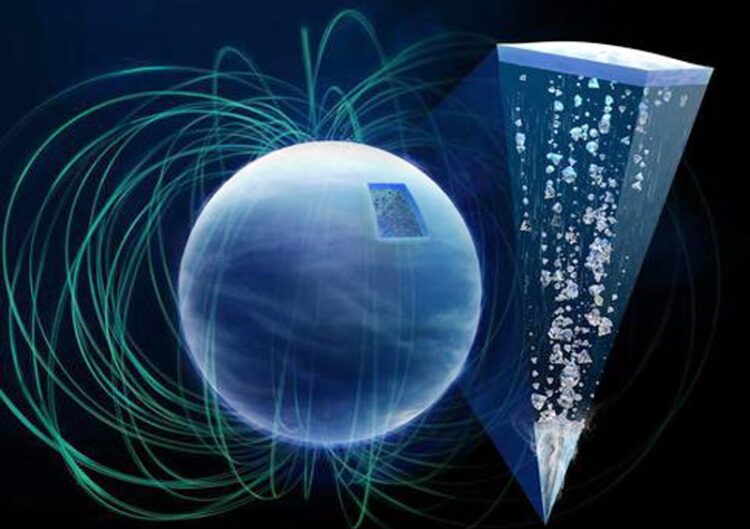New findings on diamond rain on ice planets

The graphic shows the diamond rain inside the planet, which consists of diamond sinking to through surrounding ice. Pressure and temperature continously increase on the way deeper inside the planet. Even in extremely hot regions, the ice remains due to the extremly high pressure.
Copyright: European XFEL / Tobias Wüstefeld
An international team of researchers led by Mungo Frost from the SLAC research centre in California has gained new insights into the formation of diamond rain on icy planets such as Neptune and Uranus, using the X-ray laser European XFEL in Schenefeld. The results, which have now been published in the scientific journal Nature Astronomy, also provide clues to the formation of the complex magnetic fields of these planets.
In earlier work on X-ray lasers, scientists had already discovered that diamonds should form from carbon compounds in the interior of the large gas planets because of the high pressure prevailing there. These would then sink further into the interior of the planets as a rain of precious stones from the higher layers.
A new experiment at the European XFEL has now shown that the formation of diamonds from carbon compounds already starts at lower pressures and temperatures than assumed. For the gas planets, this means that diamond rain already forms at a lower depth than thought, and could thus have a stronger influence on the formation of the magnetic fields. In addition, diamond rain would also be possible on gas planets that are smaller than Neptune and Uranus and are called “mini-Neptunes”. Such planets do not exist in our solar system, but they do occur as exoplanets outside of it.
On their way from the outer to the inner layers of the planets, the diamond rain can entrain gas and ice, causing currents of conductive ice. Currents of conductive fluids act as a kind of dynamo through which the magnetic fields of planets are formed. “The diamond rain probably has an influence on the formation of the complex magnetic fields of Uranus and Neptune,” Frost said.
The group used a plastic film made from the hydrocarbon compound polystyrene as a carbon source. Under very high pressure, diamonds are formed from the foil – a process that takes place in the same way as in the interior of planets and which can be imitated at the European XFEL. The researchers generated the high pressure and the temperature of more than 2200 degrees Celsius that prevail inside the icy gas giants with the help of diamond stamp cells and lasers. The stamp cells function like a mini vice in which the sample is squeezed between two diamonds. With the help of the European XFEL X-ray pulses, the time, conditions and sequence of the formation of the diamonds in the stamp cell can be precisely observed.
The international research team also includes scientists from European XFEL, the German research centres DESY in Hamburg and the Helmholtz Centre Dresden-Rossendorf, as well as other research institutions and universities from different countries. The European XFEL user consortium HIBEF, involving the research centres HZDR and DESY, contributed significantly to this work. “Through this international collaboration, we have made great progress at the European XFEL and gained remarkable new insights into icy planets,” says Frost.
Media contact:
Dr. Bernd Ebeling
Email: bernd.ebeling@xfel.eu
Tel. +49 40 8998 9 6921
Wissenschaftliche Ansprechpartner:
Dr. Mungo Frost
SLAC National Accelerator Laboratory
Email: mdfrost@slac.standford.edu
Originalpublikation:
M. Frost et al., Diamond Precipitation Dynamics from Hydrocarbons at Icy Planet Interior Conditions, “Nature Astronomy”, 2024, https://www.nature.com/articles/s41550-023-02147-x
DOI 10.1038/s41550-023-02147-x
Weitere Informationen:
https://www.xfel.eu/news_and_events/news/index_eng.html?openDirectAnchor=2269&am…
Media Contact
All latest news from the category: Physics and Astronomy
This area deals with the fundamental laws and building blocks of nature and how they interact, the properties and the behavior of matter, and research into space and time and their structures.
innovations-report provides in-depth reports and articles on subjects such as astrophysics, laser technologies, nuclear, quantum, particle and solid-state physics, nanotechnologies, planetary research and findings (Mars, Venus) and developments related to the Hubble Telescope.
Newest articles

Red light therapy for repairing spinal cord injury passes milestone
Patients with spinal cord injury (SCI) could benefit from a future treatment to repair nerve connections using red and near-infrared light. The method, invented by scientists at the University of…

Insect research is revolutionized by technology
New technologies can revolutionise insect research and environmental monitoring. By using DNA, images, sounds and flight patterns analysed by AI, it’s possible to gain new insights into the world of…

X-ray satellite XMM-newton sees ‘space clover’ in a new light
Astronomers have discovered enormous circular radio features of unknown origin around some galaxies. Now, new observations of one dubbed the Cloverleaf suggest it was created by clashing groups of galaxies….





















